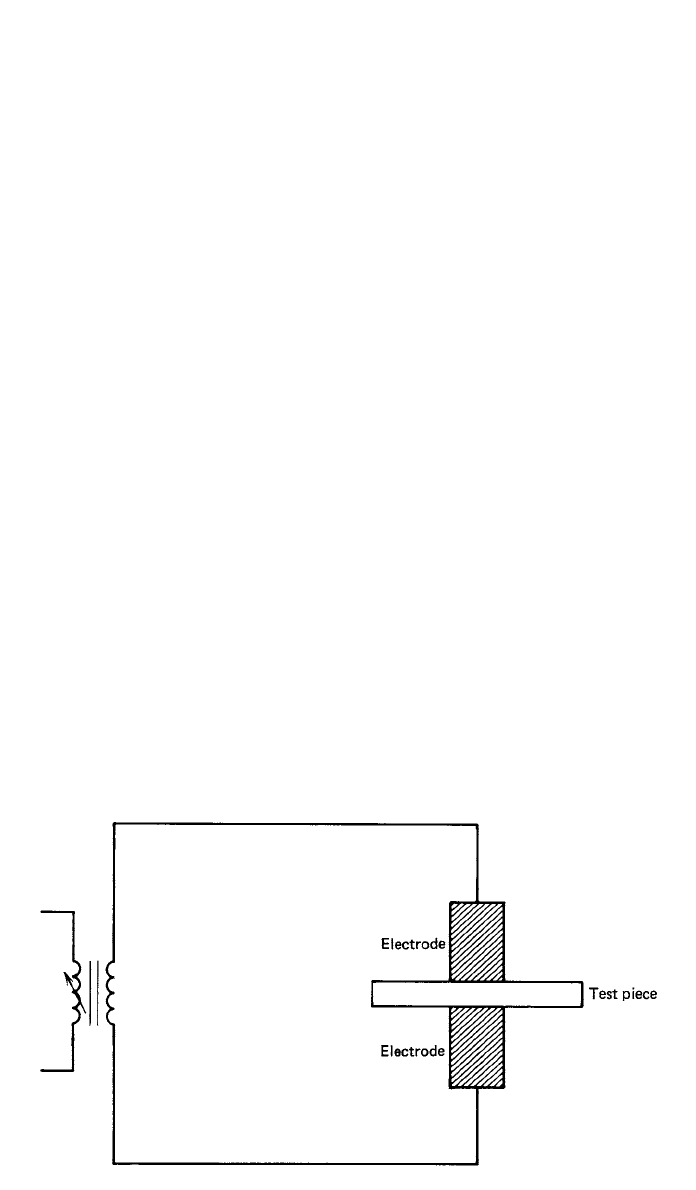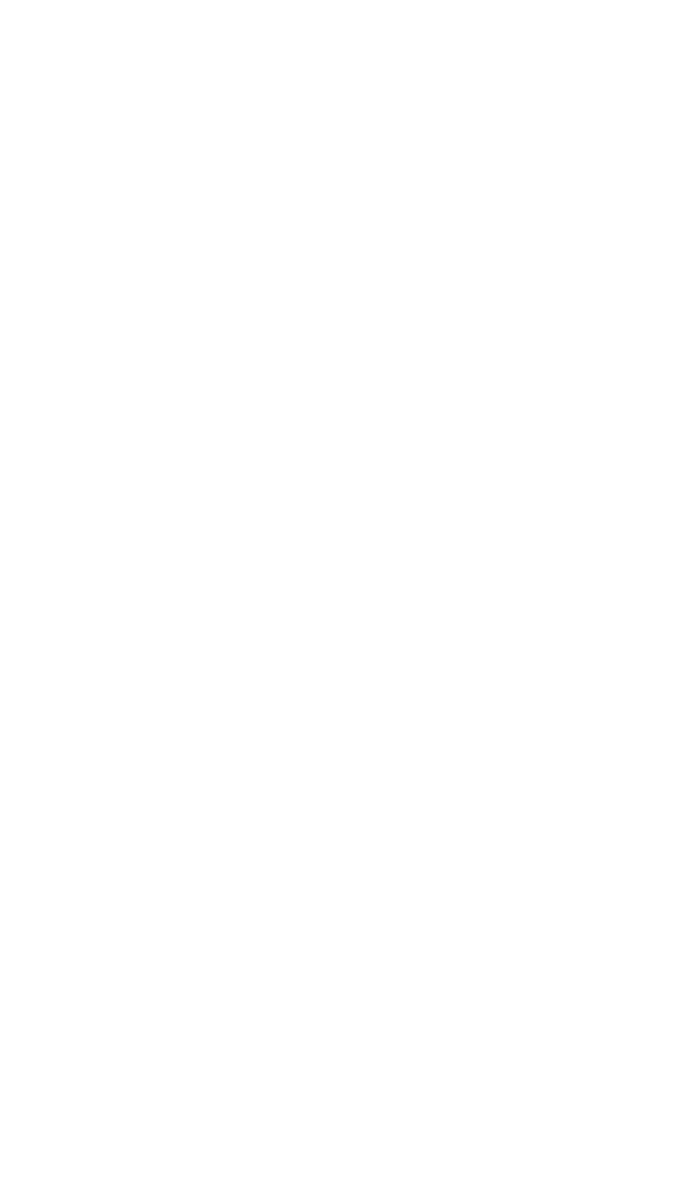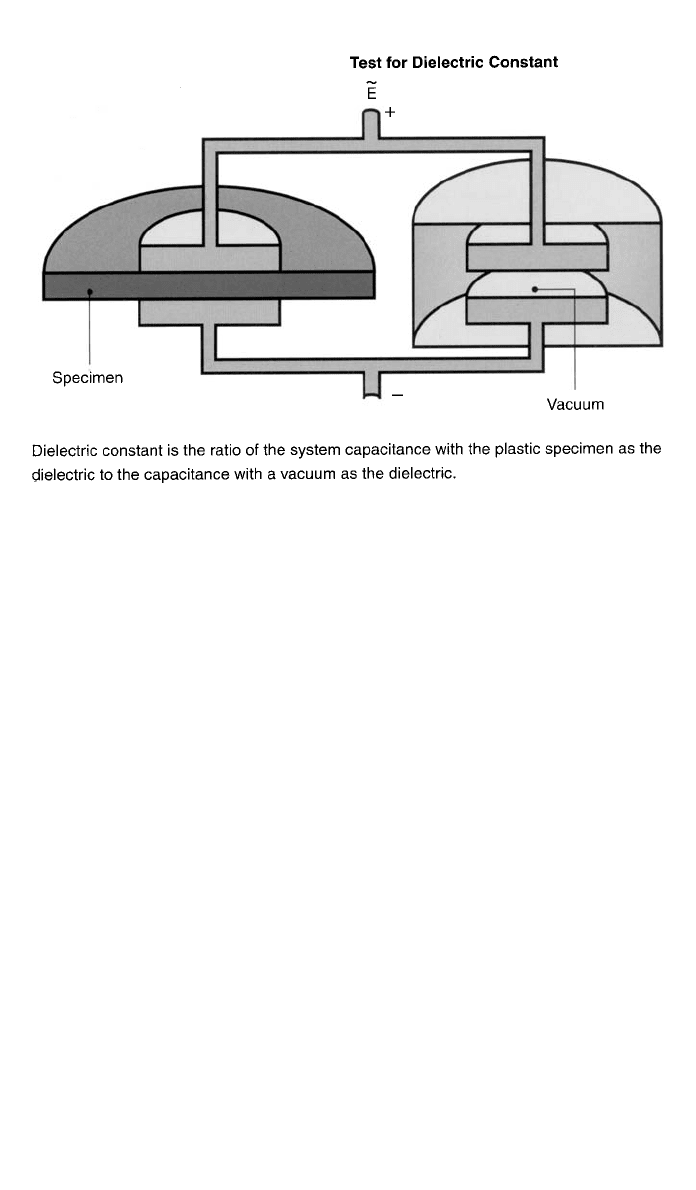Kutz M. Handbook of materials selection
Подождите немного. Документ загружается.


568 PLASTICS TESTING
correlation in the overlapping regions is possible. However, due to differences
in elasticity, creep, and shear characteristics between different plastics, a general
correlation is not possible.
Durometer Hardness (ASTM D2240, ISO 868)
The Durometer hardness test is mostly used for measuring the relative hardness
of soft materials. The test method is based on the penetration of a specified
indentor forced into the material under specified conditions.
The Durometer hardness tester consists of a pressure foot, an indentor, and
an indicating device. The indentor is spring loaded and the point of the indentor
protrudes through the hole in the base. The test specimens are at least thick
1
–
-in.
4
and can be either molded or cut from a sheet. Several thin specimens may be
piled to form a -thick specimen but one piece specimens are preferred. The
1
–
-in.
4
poor contact between the thin specimens may cause results to vary considerably.
The test is carried out by first placing a specimen on a hard, flat surface. The
pressure foot of the instrument is pressed onto the specimen, making sure that
it is parallel to the surface of the specimen. The durometer hardness is read
within 1 sec after the pressure foot is in firm contact with the specimen.
Two types of durometers are most commonly used—type A and type D. The
basic difference between the two types is the shape and dimension of the in-
dentor. The hardness numbers derived from either scale are just numbers without
any units. Type A durometer is used with relatively soft material while type D
durometer is used with slightly harder material.
2 THERMAL PROPERTIES
Thermal properties of plastic materials are equally as important as mechanical
properties. Unlike metals, plastics are extremely sensitive to changes in temper-
ature. The mechanical, electrical, or chemical properties of plastics cannot be
looked at without looking at the temperature at which the values were derived.
Crystallinity has a number of important effects upon the thermal properties of a
polymer. Its most general effects are the introduction of a sharp melting point
and the stiffening of thermal mechanical properties. Amorphous plastics, in con-
trast, have a gradual softening range. Molecular orientation also has a significant
effect on thermal properties. Orientation tends to decrease dimensional stability
at higher temperatures. The molecular weight of the polymer affects the low-
temperature flexibility and low-temperature brittleness. Many other factors such
as intermolecular bonding, cross-linking, and copolymerization all have a con-
siderable effect on thermal properties. From the above discussion, it is very clear
that the thermal behavior of polymeric materials is rather complex. Therefore,
in designing a plastic part or selecting a plastic material from the available
thermal property data, one must thoroughly understand the short-term as well
as the long-term effect of temperature on properties of that plastic material.
2.1 Tests for Elevated Temperature Performance
Designers and material selectors of plastic products constantly face the challenge
of selecting a suitable plastic for elevated temperature performance. The diffi-
culty arises due to the varying natures and capabilities of various types and
grades of plastics at elevated temperatures. Many factors are considered when
selecting a plastic for a high-temperature application. The material must be able

2 THERMAL PROPERTIES 569
to support a design load under operating conditions without objectionable creep
or distortion. The material must not degrade or lose necessary additives that will
cause drastic reduction in the physical properties during the expected service
life.
All the properties of plastic materials are not affected in a similar manner by
elevating temperature. For example, electrical properties of a particular plastic
may show only a moderate change at elevated temperatures, while the mechan-
ical properties may be reduced significantly. Also, since the properties of plastic
materials vary with temperature in an irregular fashion, they must be looked at
as a function of temperature in order to obtain more meaningful information.
From the foregoing, it is quite clear that a single maximum-use temperature that
will apply to all the important properties in high-temperature applications is
simply not possible.
One of the most important considerations while studying the performance of
plastics at elevated temperatures is the dependence of key properties such as
modulus, strength, chemical resistance, and environmental resistance on time.
Therefore, the short-term heat resistance data alone is not adequate for designing
and selecting materials that require long-term heat resistance. For the sake of
convenience and simplicity, we divide the elevated temperature effects into two
categories:
1. Short-term effects
a. Heat deflection temperature
b. Vicat softening temperature
c. Torsion pendulum
2. Long-term effects
a. Long-term heat resistance test
b. Underwriters Laboratory (UL) temperature index
c. Creep modulus/creep rupture tests
Short-Term Effects
Heat Deflection Temperature (HDT)(ASTM D648, ISO 75-1, ISO 75-2).
Heat deflection temperature is defined as the temperature at which a standard
test bar (5
⫻⫻in.) deflects 0.010 in. under a stated load of either 66 or
11
––
24
264 psi. The heat deflection temperature test, also referred to as the heat distor-
tion temperature test, is commonly used for quality control and for screening
and ranking materials for short-term heat resistance. The data obtained by this
method cannot be used to predict the behavior of plastic materials at elevated
temperature nor can it be used in designing a part or selecting and specifying
material. Heat deflection temperature is a single-point measurement and does
not indicate long-term heat resistance of plastic materials. Heat distortion tem-
perature, however, does distinguish between those materials that lose their rigid-
ity over a narrow temperature range and those that are able to sustain light loads
at high temperatures.
The apparatus for measuring heat deflection temperature consists of an en-
closed oil bath fitted with a heating chamber and automatic heating controls that
raise the temperature of the heat transfer fluid at a uniform rate. A cooling

570 PLASTICS TESTING
Fig. 15 DTUL/ vicat tester. (Courtesy Atlas Electric Devices Company)
system is also incorporated to fast cool the heat transfer medium for conducting
repeated tests. The specimens are supported on steel supports, 4 in. apart with
the load applied on top of the specimen vertically and midway between the
supports. The contact edges of the support and of the piece by which pressure
is applied is rounded to a radius of in. A suitable deflection measurement
1
–
4
device, such as a dial indicator, is normally used. A mercury thermometer is
used for measuring temperature. The unit is capable of applying 66 or 264 psi
fiber stress on specimens by means of a dead weight. A commercially available
heat deflection measuring device with a closeup of a specimen holder is illus-
trated in Fig. 15.
More recently, automatic heat deflection temperature testers have been de-
veloped. These testers typically replace conventional temperature and deflection
measuring devices with more sophisticated electronic measuring devices with
digital read-out system and a chart recorder that prints out the results. Such an
automatic apparatus eliminates the need for the continuous presence of an op-
erator and thereby minimizes operator-related errors.
The test specimens consist of test bars 5 in. in length, in. in depth by any
1
–
2
width from to in. The test bars may be molded or cut from extruded sheet
11
––
82
as long as they have smooth, flat surfaces and are free from excessive sink marks
or flash. The specimens are conditioned employing standard conditioning pro-
cedures.
The specimen is positioned in the apparatus along with the temperature and
deflection measuring devices and the entire assembly is submerged into the oil
bath kept at room temperature. The load is applied to a desired value (66 or 264
psi fiber stress). Five minutes after applying the load, the pointer is adjusted to
zero and the oil is heated at the rate of 2
Ⳳ 0.2⬚C/min. The temperature of the

2 THERMAL PROPERTIES 571
oil at which the bar has deflected 0.010 in. is recorded as the heat deflection
temperature at the specified fiber stress.
Long-Term Effects
The long-term effects of elevated temperature on properties of plastics are ex-
tremely important, especially when one considers the fact that the majority of
applications involving high heat are long-term applications. During long-term
exposure to heat, plastic materials may encounter many physical and chemical
changes. A plastic material that shows little or no effect at elevated temperature
for a short time may show a drastic reduction in physical properties, a complete
loss of rigidity, and severe thermal degradation when exposed to elevated tem-
perature for a long time. Along with time and temperature, many other factors
such as ozone, oxygen, sunlight, and pollution combine to accelerate the attack
on plastics. At elevated temperatures, many plastics tend to lose important ad-
ditives such as plasticizers and stabilizers, causing plastics to become brittle or
soft and sticky.
Three basic tests have been developed and accepted by the plastics industry.
If the application does not require the product to be exposed to elevated tem-
perature for a long period under continuous load, a simple heat resistance test
is adequate. The applications requiring the product to be under continuous sig-
nificant load must be looked at from creep modulus and creep rupture strength
test data. Another one of the most widely accepted methods of measuring max-
imum continuous use temperature has been developed by Underwriters Labo-
ratories. The UL temperature index, established for a variety of plastic materials
to be used in electrical applications, is the maximum temperature that the ma-
terial may be subjected to without fear of premature thermal degradation.
Long-Term Heat Resistance Test (ASTM D794). The long-term heat resis-
tance test was developed to determine the permanent effect of heat on any prop-
erty by selection of an appropriate test method and specimen. In ASTM
recommended practice, only the procedure for heat exposure is specified and not
the test method or specimen.
Any specimen, including sheet, laminate, test bar, or molded part may be
used. If a specific property, such as tensile strength loss is to be determined, a
standard tensile test bar specimen and procedures must be used for comparison
of test results before and after the test. The test requires the use of a mechanical
convection oven with a specimen rack of suitable design to allow air circulation
around the specimens. The test is carried out by simply placing the specimen in
the oven at a desired exposure temperature for a predetermined length of time.
The subsequent exposure to temperatures may be increased or decreased in steps
of 25
⬚C until a failure is observed. Failure due to heat is defined as a change in
appearance, weight, dimension, or other properties that alter plastic material to
a degree that it is no longer acceptable for the service in question. Failure may
result from blistering, cracking, loss of plasticizer, or other volatile material that
may cause embrittlement, shrinkage, or change in desirable electrical or me-
chanical properties.
Many factors that affect the reproducibility of the data. The degree of tem-
perature control in the oven, the type of molding, cure, air velocity over the

572 PLASTICS TESTING
specimen, period of exposure, and humidity of the oven room are some of these
factors. The amount and type of volatiles in the molded part or specimen may
also affect the reproducibility.
UL Temperature Index. The increased use of plastic materials in electrical
applications such as appliances, portable electrically operated tools and equip-
ments, and enclosures has created a renewed interest in the ability of plastics to
withstand mechanical abuse and high temperatures. A serious personal injury,
electric shock, or fire may occur if the product does not perform its intended
function. Underwriters Laboratories, an independent, not-for-profit organization
concerned with consumer safety, has developed a temperature index to assist UL
engineers in judging the acceptability of individual plastics in specific applica-
tions involving long-term exposure to elevated temperatures. The UL tempera-
ture index correlates numerically with the temperature rating or maximum
temperature in degrees centigrade above which a material may degrade prema-
turely and therefore be unsafe.
Relative Thermal Indices. The relative thermal index of a polymeric material
is an indication of the material’s ability to retain a particular property (physical,
electrical, etc.) when exposed to elevated temperatures for an extended period
of time. It is a measure of the material’s thermal endurance. For each material,
a number of relative thermal indices can be established, each index related to a
specific thickness of the material.
The relative index of a material is determined by comparing the thermal-
aging characteristic of one material of proven field service at a particular tem-
perature level with the thermal-aging characteristics of another material with no
field service history. A great deal of consideration is given to the properties that
are evaluated to determine relative thermal index. For the relative thermal index
to be valid, the properties being stressed in the end product must be included in
the thermal-aging program. If, for any reason, the specific property under stress
in the end product is not part of the long-term aging program, the relative thermal
index may not be applicable to the use of the material in that particular appli-
cation.
Relative Thermal Index Based upon Historical Records. Through experience
gained from testing a large volume of complete products and insulating systems
over a long period, UL has established relative thermal indices on certain types
of plastics. These fundamental temperature indices are applicable to each mem-
ber of a generic material class. Table 2 lists the temperature indices based on
past field test performance and chemical structure.
Relative Thermal Index Based upon Long-Term Thermal Aging. The long-
term thermal-aging program consists of exposing polymeric materials to heat for
a predetermined length of time and observing the effect of thermal degradation.
To carry out the testing, an electrically heated mechanical convection oven is
preferred, however, with some provisions, a noncirculating static oven may be
employed. The specific properties to be evaluated in the thermal-aging program
are to be as nearly as possible representative of the properties required in the
end application.

2 THERMAL PROPERTIES 573
Table 2 Relative Thermal Indices Based upon Past
Field Test Performance and Chemical Structure
a
Material
Generic Thermal
Index (⬚C)
Nylon (type 6, 11, 6 / 6, and 6 / 10)
b
65
Polycarbonate
b
65
Molded phenolic
c,d
150
Molded melamine
c,d
130
e
Molded melamine-phenolic
c,d
130
e
Fluorocarbin resins
(1) Polytetrafluoroethylene 150
(2) Polychlorotrifluoroethylene 150
(3) Fluorinated ethylene propylene 150
Silicone rubber 105
Polyethylene terephthalate film 105
Urea formaldehyde 100
Molded alkyd
c,d
130
Molded epoxy
c,d
130
Molded diallyl phthalate
c,d
130
Molded polyester
c,d
(thermosetting) 130
a
From UL 746 B. Reprinted with permission from Under-
writers Laboratories, Inc.
b
Includes glass fiber-reinforced materials.
c
Includes simultaneous heat and high-pressure matched metal
die-molded compounds only. Excludes low-pressure or low-
temperature curing processes such as open-mold (hand lay-
up, spray-up, contact bag, filament winding), encapsulation,
lamination, etc.
d
Includes materials having filler systems of fibrous (other than
synthetic organic) types but excludes fiber reinforcement sys-
tems using resins that are applied in liquid form.
e
Compounds having a specific gravity of 1.55 or greater (in-
cluding those having cellulosic filler material) are acceptable
at temperatures not greater than 150
⬚C (302⬚F).
The most common mechanical properties include tensile strength, flexural
strength, and Izod impact strength. The electrical properties of concern are di-
electric strength, surface or volume resistivity, arc resistance, and arc tracking.
The test specimens are standard ASTM test bars, depending upon the type of
test. The UL publication, ‘‘Polymeric Materials—Short-Term Property Evalua-
tions, UL 746A,’’ describes the specimen and test procedures to determine me-
chanical and electrical properties.
To determine the relative thermal index, a control material with a record of
good field service at its rated temperature is selected. The control material of
the same generic type and the same thickness as the candidate material is pre-
ferred. At least four different oven temperatures are selected. The highest tem-
perature is selected so that it will take no more than 2 months to produce end
of life of the material. The next two lower temperatures must produce the an-
ticipated end of life of 3 and 6 months, respectively. The lowest temperature
selected will take 9 to 12 months for the anticipated results.
The end of life of a material is based upon the assumption that at least a
2:1 factor of safety exists in the applicable physical and electrical property re-

574 PLASTICS TESTING
quirements. The end of life of a material is the time at each aging temperature,
when a property value has decreased 50% of its unaged level. A 50% loss of
property due to thermal degradation is not expected to result in premature, unsafe
failure.
To avoid underrating the material’s relative temperature index, UL publishes
the ratings in three categories: applications involving electrical properties only,
applications involving both electrical and mechanical properties, and applications
involving both electrical and mechanical properties without impact resistance.
UL publishes such data in its semiannual Plastics Recognized Component Di-
rectory. Since the long-term heat-aging resistance of plastics is dependent on the
thickness of the part or test specimen, UL requires that the thermal index testing
be carried out over a wide range of thicknesses. Finally, it is important to un-
derstand that the UL temperature index program recognizes that the upper tem-
perature limits of plastics are dependent upon the stresses applied on the end
product in use. Consequently, the temperature index of a particular plastic qual-
ifies it only for those UL applications that UL has specifically approved.
2.2 Brittleness Temperature (ASTM D746, ISO 974)
At low temperatures, all plastics tend to become rigid and brittle. This happens
mainly because, at lower temperatures, the mobility of polymer chains is greatly
reduced. In the case of the amorphous polymers, brittle failure occurs at a tem-
perature well below glass transition temperature. The polymer tends to get
tougher as it reaches glass transition temperature. By contrast, in crystalline
polymers the toughness is mainly dependent on the degree of crystallinity, which
generally creates molecular inflexibility resulting in only moderate impact
strength. The size of the crystalline structure formed also has significant effect
on the impact strength of the polymer. The larger the crystalline structure, the
lower the impact strength. The polymers exhibiting ductile failure generally
show high plastic deformation characterized by material stretching and tearing
before fracturing. Brittleness temperature is defined as the temperature at which
plastics and elastomers exhibit brittle failure under impact conditions. Yet an-
other way to define brittleness temperature is the temperature at which 50% of
the specimens tested exhibit brittle failure under specified impact conditions.
3 ELECTRICAL PROPERTIES
The unbeatable combination of characteristics such as ease of fabrication, low
cost, light weight, and excellent insulation properties have made plastics one of
the most desirable materials for electrical applications. Although the majority of
applications involving plastics are insulation related, plastics can be made to
conduct electricity by simply modifying the base material with proper additives
such as carbon black.
Until recently, plastics were considered a relatively weaker material in terms
of load-bearing properties at elevated temperatures. Therefore, the use of plastics
in electrical applications was limited to non-load-bearing, general-purpose ap-
plications. The advent of new high-performance engineering materials has al-
tered the entire picture. Plastics are now specified in a majority of applications
requiring resistance to extreme temperatures, chemicals, moisture, and stresses.
The primary function of plastics in electrical applications has been that of an

3 ELECTRICAL PROPERTIES 575
Fig. 16 Schematic of dielectric strength test.
insulator. This insulator or dielectric separates two field-carrying conductors.
Such a function can be served equally well by air or vacuum. However, neither
air nor vacuum can provide any mechanical support to the conductors. Plastics
not only act as effective insulators but also provide mechanical support for field-
carrying conductors. For this very reason, the mechanical properties of plastic
materials used as insulators become very important. Typical electrical applica-
tions of plastic material include plastic-coated wires, terminals, connectors, in-
dustrial and household plugs, switches, and printed circuit boards.
The key electrical properties of interest are dielectric strength, dielectric con-
stant, dissipation factor, volume and surface resistivity, and arc resistance.
3.1 Dielectric Strength (ASTM D149, IEC 243-1)
The dielectric strength of an insulating material is defined as the maximum
voltage required to produce a dielectric breakdown. Dielectric strength is ex-
pressed in volts per unit of thickness such as V/mil. All insulators allow a small
amount of current to leak through or around themselves. Only a perfect insulator,
if there is such an insulator in existence, can be completely free from small
current leakage. The small leakage generates heat, providing an easier access to
more current. The process slowly accelerates with time and the amount of volt-
age applied until a failure in terms of dielectric breakdown or what is known as
puncture occurs. Obviously, dielectric strength, which indicates electrical
strength of a material as an insulator, is a very important characteristic of an
insulating material. The higher the dielectric strength, the better the quality of
an insulator. Three basic procedures have been developed to determine dielectric
strength of an insulator. Figure 16 schematically illustrates the basic setup for a
dielectric strength test. A variable transformer and a pair of electrodes are nor-
mally employed. Specimens of any desirable thickness prepared from the ma-
terial to be tested are used. Specimen thickness of in. is fairly common. The
1
––
16
first procedure is known as the short-times method. In this method, the voltage
is increased from zero to breakdown at a uniform rate. The rate of rise is gen-

576 PLASTICS TESTING
erally 100, 500, 1000, or 3000 V/s until the failure occurs. The failure is made
evident by actual rupture or decomposition of the specimen. Sometimes a circuit
breaker or other similar device is employed to signal the voltage breakdown.
This is not considered a positive indication of voltage breakdown since other
factors such as flashover, leakage current, corona current, or equipment mag-
netizing current can influence such indicating devices.
The second method is known as the slow-rate-of-rise method. The test is
carried out by applying the initial voltage approximately equal to 50% of the
breakdown voltage as determined by the short-time test or as specified. Next,
the voltage is increased at a uniform rate until the breakdown occurs.
The step-by-step test method requires applying initial voltage equal to 50%
of the breakdown voltage as determined by the short-time test and then increas-
ing the voltage in equal increments and held for specified time periods until the
specimen breaks down. In almost all cases the dielectric strength values obtained
by step-by-step method corresponds better with actual use conditions. However,
the service failures are generally at voltage below the rated dielectric strength
because of the time factor involved.
3.2 Dielectric Constant and Dissipation Factor (ASTM D150, IEC 250)
Dielectric Constant (Permittivity)
Dielectric constant of an insulating material is defined as the ratio of the charge
stored in an insulating material placed between two metallic plates to the charge
that can be stored when the insulating material is replaced by air (or vacuum).
Defined another way, the dielectric constant is the ratio of the capacitance by
two metallic plates with an insulator placed between them and the capacitance
of the same plates with a vacuum between them. Simply stated, the dielectric
constant indicates the ability of an insulator to store electrical energy. In many
applications, insulating materials are required to perform as capacitors. Such
applications are best served by plastic materials having a high dielectric constant.
Materials with a high dielectric constant have also helped in reducing the phys-
ical size of the capacitors. Furthermore, the thinner the insulating material, the
higher the capacitance. Because of this fact plastic foils are extensively used in
applications requiring high capacitance.
One of the main function of an insulator is to insulate the current-carrying
conductors from each other and from the ground. If the insulator is used strictly
for this purpose, it is desirable to have the capacitance of the insulating material
as small as possible. For these applications, one is looking for the materials with
very low dielectric constant.
The dielectric constant test is fairly simple. The test specimen is placed be-
tween the two electrodes, as shown in Fig. 17, and the capacitance is measured.
Next, the test specimen is replaced by air and once again the capacitance value
is measured. The dielectric constant value is determined from the ratio of the
two measurements. Dielectric constant values are affected by factors such as
frequency, voltage, temperature, humidity, etc.
Dissipation Factor
In all electrical applications, it is desirable to keep the electrical losses to a
minimum. Electrical losses indicate the inefficiency of an insulator. The dissi-

3 ELECTRICAL PROPERTIES 577
Fig. 17 Schematic of dielectric constant test. (Courtesy Bayer Corporation)
pation factor is a measure of such electrical inefficiency of the insulating ma-
terial. The dissipation factor indicates the amount of energy dissipated by the
insulating material when the voltage is applied to the circuit. The dissipation
factor is defined as the ratio of the conductance of a capacitor in which the
material is the dielectric to its susceptance or the ratio of its parallel reactance
to its parallel resistance. Most plastics have a relatively lower dissipation factor
at room temperature. However, at high temperatures, the dissipation factor is
quite high, resulting in greater overall inefficiency in electrical system. Loss
factor, which is the product of dielectric constant and the dissipation factor, is
a frequently used term since it relates to the total loss of power occurring in
insulating materials.
3.3 Electrical Resistance Tests
As stated earlier, the primary function of an insulator is to insulate current-
carrying conductors from each other as well as from ground and to provide
mechanical support for components. Naturally, the most desirable characteristic
of an insulator is its ability to resist the leakage of the electrical current. The
higher the insulation resistance, the better the insulator. Failure to recognize the
importance of insulation resistance values while designing products such as ap-
pliances and power tools could lead to fire, electrical shock, and personal injury.
Insulation resistance can be subdivided into:
1. Volume resistance
2. Surface resistance
Volume resistance is defined as the ratio of the direct voltage applied to two
electrodes that are in contact with a specimen to that portion of the current
